|
 Secure Site
Secure Site
|
 |
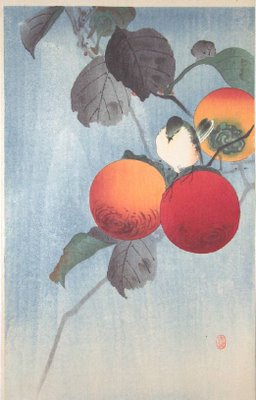 Koson's Nutcraker Atop a Persimmon, Ukiyo-e Gallery
Wabi- sabi, the art and practice of honoring the imperfect
Many Japanese arts over the past thousand years have been influenced by Zen and Mahayana philosophy, particularly acceptance and contemplation of the imperfection, constant flux, and impermanence of all things. Such arts can exemplify a wabi-sabi aesthetic.
Here is an incomplete list:
- honkyoku (traditional shakuhachi music of wandering Zen monks)
- ikebana (flower arrangement)
- Japanese gardens, Zen gardens, and bonsai (tray gardens)
- Japanese poetry, particularly haiku
- Japanese pottery, notably Hagi ware
- Japanese tea ceremony
- Bonsai the Japanese art of miniature trees
from wikipedia.org
 Zen Timepiece with brass bowl
Posted in Japanese Inspired Zen Clocks, Now & Zen Alarm Clocks, wabi-sabi
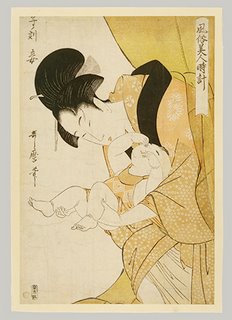 Mother and Child Ukiyoe Woodblock Print from Japan Here at Now & Zen we love to look at the old woodblock prints produced during the Japanese Genre of Ukiyo-e or also known as, ‘The Floating World’. Below is a description (From Wikipedia, the free encyclopedia):
Ukiyo-e (“pictures of the floating world”) is a genre of Japanese woodblock prints (or woodcuts) and paintings produced between the 17th and the 20th centuries, featuring motifs of landscapes, tales from history, the theatre, and pleasure quarters. It is the main artistic genre of woodblock printing in Japan.
Usually the word ukiyo is literally translated as “floating world” in English, referring to a conception of an evanescent world, impermanent, fleeting beauty and a realm of entertainments (kubuki, courtesans, geisha) divorced from the responsibilities of the mundane, everyday world; “pictures of the floating world”, i.e. ukiyo-e, are considered a genre unto themselves.
The contemporary novelist Asai, in his Ukiyo monogatari ( “Tales of the Floating World”, c. 1661), provides some insight into the concept of the floating world:
“… Living only for the moment, turning our full attention to the pleasures of the moon, the snow, the cherry blossoms and the maple leaves; singing songs, drinking wine, diverting ourselves in just floating, floating; … refusing to be disheartened, like a gourd floating along with the river current: this is what we call the floating world…”
 Zen Clock with Chime Inspired by Ukiyoe Prints and Ink Painting techniques from Japan Now & Zen Store
1638 Pearl Street
Boulder, CO 80302
Posted in Japanese Inspired Zen Clocks, Now & Zen Alarm Clocks
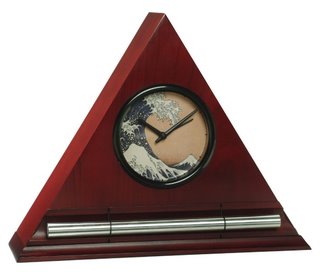 Hokusai Wave Zen Alarm Clock by Now & Zen, Boulder, CO Now & Zen’s first Zen Alarm Clock dial face was inspired by the great Japanese printmaker, Hokusai. Steve McIntosh’s love of ukiyo-e lead him to the print by Hokusai called, ‘The Great Wave off Kanagawa’.
Katsushika Hokusai was a Japanese artist, ukiyo-e painter and printmaker of the Edo period. In his time, he was Japan’s leading expert on Chinese painting. Born in Edo (now Tokyo), Hokusai is best-known as author of the woodblock print series Thirty-six Views of Mount Fuji which includes the iconic and internationally recognized print,The Great Wave off Kanagawa, created during the 1820s.
 The Great Wave off Kanagawa by Hokusai Ukiyo-e, as practiced by artists like Hokusai, focused on images of the courtesans and Kabuki actors who were popular in Japan’s cities at the time.
Hokusai eventually changed the subjects of his works, moving away from the images of courtesans and actors that were the traditional subjects of ukiyo-e. Instead, his work became focused on landscapes and images of the daily life of Japanese people from a variety of social levels.
Hokusai had a long career, but he produced most of his important work after age 60. His most popular work is the ukiyo-e series Thirty-six Views of Mount Fuji, which was created between 1826 and 1833. It actually consists of 46 prints (10 of them added after publication). In addition, he is responsible for the 1834 One Hundred Views of Mount Fuji ) a work which “is generally considered the masterpiece among his landscape picture books.”
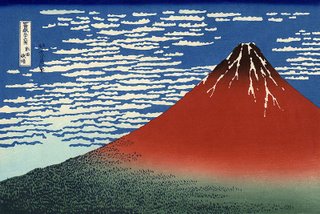 Red Fuji Ukiyo-e Print by Hokusai's series: Thirty-six Views of Mount Fuji Mount Fuji has traditionally been linked with eternal life.
His influences also stretched to his contemporaries in nineteenth century Europe whose new style Art Nouveau, or Jugendstil in Germany, was influenced by him and by Japanese art in general. This was also part of the larger Impressionist movement, with similar themes to Hokusai appearing inClaude Monet and Pierre-Auguste Renoir.
 Steve McIntosh, Founder of Now & Zen, Boulder, CO All Now & Zen products have been conceived and designed by Steve McIntosh. Steve’s love of beauty and passion for spiritual practice led him to found Now & Zen with the goal of creating products that would make a real difference in people’s lives. Steve created Now & Zen’s brand aesthetic by combining the harmonic proportions of sacred geometry with motifs from traditional Japanese culture. This has resulted in product designs that have a timeless, universal appeal.
Now & Zen Headquarter Store
1638 Pearl Street
Boulder, CO 80302
Posted in Beauty, Hokusai Wave, Japanese Inspired Zen Clocks, Now & Zen Alarm Clocks
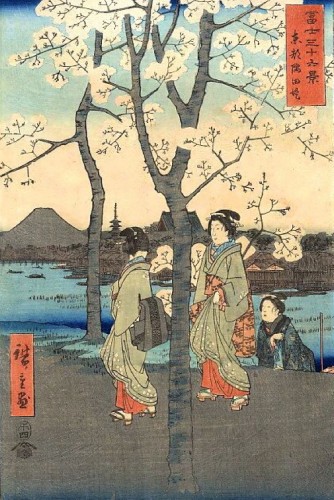 Flower Viewing- Woodblock print of Mount Fuji and cherry blossom from 36 Views of Mount Fuji by Hiroshige. Spring in Boulder, Colorado – Time for a ‘Flower-viewing’ Party!
Here at Now & Zen one of our favorite ways to relax is to view the Cherry Blossoms in Japan. Of course, it is not possible to travel so far away very often, so we try to take a moment to enjoy flowering trees and flowers each day during the spring-time in Boulder, Colorado.
Here is a brief description of the origins of the “Flower viewing” tradition in Japan:
Hanami (“flower viewing”) is the Japanese traditional custom of enjoying the beauty of flowers, “flower” in this case almost always meaning cherry blossoms, or ume blossoms. From mid January to early May, sakura bloom all over Japan. The blossom forecast is announced each year by the weather bureau, and is watched carefully by those planning hanami as the blossoms only last a week or two. In modern-day Japan, hanami mostly consists of having an outdoor party beneath the sakura during daytime or at night. Hanami at night is called yozakura.
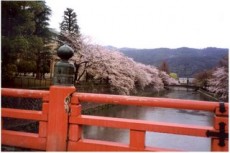 Flower Viewing- Cherry Blossoms in Kyoto During the Heian Period (794–1191), Japanese sought to emulate many practices from China, including the social phenomenon of flower viewing where the imperial households, poets, singers and other aristocrats would gather and celebrate under the blossoms. In Japan, cherry trees were planted and cultivated for their beauty, for the adornment of the grounds of the nobility of Kyoto, at least as early as 794. In China, the ume “plum” tree (actually a species of apricot) was held in highest regard, but by the middle of the ninth century, the cherry blossom had replaced the plum as the favored species in Japan.
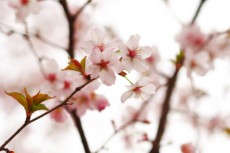 Flower Viewing- Sakura spring blossoms Emperor Saga of the Heian Period adopted this practice, and held Flower viewing parties with sake and feasts underneath the blossoming boughs of sakura trees in the Imperial Court in Kyoto. Poems would be written praising the delicate flowers, which were seen as a metaphor for life itself, luminous and beautiful yet fleeting and ephemeral. This was said to be the origin of hanami in Japan.
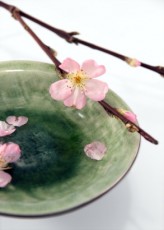 Flower Viewing- Cherry Blossoms Hanami festivals celebrate the beauty of the cherry blossom and for many are a chance to relax and enjoy the beautiful view.
Now & Zen Headquarter Store
1638 Pearl Street
Boulder, CO 80302
(800) 779-6383
Posted in Beauty, Japanese Inspired Zen Clocks, Now & Zen Alarm Clocks
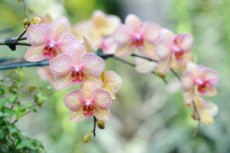 Elegant orchids in blossom
Our favorite Zen spiritual practice is flower arranging. As Buddhist monk Thich Nhat Hanh says of this beauty practice, “As you arrange the flowers, so too will you be arranged. And as you are arranged, so will your family be arranged. And as your family is arranged, so will the world be arranged.”
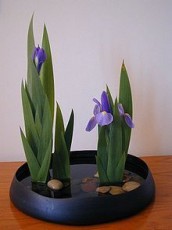 Ikebana Here’s a description of “the way of flowers.”
Ikebana is the Japanese Art of flower arrangement, also known askadō , the “way of flowers”). More than simply putting flowers in a container, ikebana is a disciplined art form in which nature and humanity are brought together.
Contrary to the idea of floral arrangement as a collection of particolored or multicolored arrangement of blooms, ikebana often emphasizes other areas of the plant, such as its stems and leaves, and draws emphasis toward shape, line and form.
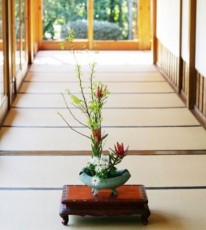 Ikebana Though ikebana is a creative expression, it has certain rules governing its form. The main rule is that all the elements used in construction must be organic, be they branches, leaves, grasses, or flowers. The artist’s intention behind each arrangement is shown through a piece’s color combinations, natural shapes, graceful lines, and the usually implied meaning of the arrangement.

Another aspect present in ikebana is its employment of minimalism. That is, an arrangement may consist of only a minimal number of blooms interspersed among stalks and leaves.
The structure of a Japanese flower arrangement is based on a scalene triangle delineated by three main points, usually twigs, considered in some schools to symbolize heaven, earth and man and in others sun, moon, love, and earth.
The container is a key element of the composition, and various styles of pottery may be used in their construction.
Visit Now & Zen’s Headquarter Store, 1638 Pearl Street, Boulder, CO 80302 (800)779-6383
Posted in Japanese Inspired Zen Clocks, Now & Zen Alarm Clocks
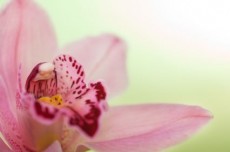 Beauty Practice Zen Clocks have been inspired by the beautiful aesthetic sensibilities of feudal Japanese art and architecture. And one of our favorite Japanese institutions in this area is the Tokonoma.
 Colorado Company: Now & Zen, Inc
Here’s a brief description:
Tokonoma, also referred to simply as toko, is a Japanese term generally referring to a built-in recessed space in a Japanese style reception room, in which items for artistic appreciation are displayed. In English, tokonoma is usually called alcove.
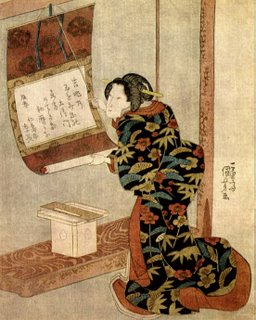 Ukiyo-e Tokonoma Print from 'Pictures of the Floating World'
When seating guests in a Japanese-style room, the correct etiquette is to seat the most important guest with his or her back facing the tokonoma. This is because of modesty; the host should not be seen to show off the contents of the tokonoma to the guest, and thus it is necessary not to point the guest towards the tokonoma. Stepping up inside it is strictly forbidden.
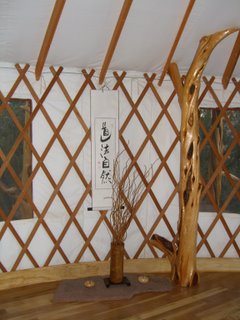 Tokonoma in Yurt
The pillar on one side of the tokonoma is usually made of a raw trunk of wood.
 Now & Zen's Founder, Steve McIntosh Builds a Tokonoma in a Yurt American architect Frank Lloyd Wright was influenced by Japanese architecture. He translated the meaning of the tokonoma into its western counterpart: the fireplace. This gesture became more of a ceremonial core in his architecture.
Posted in Japanese Inspired Zen Clocks, Now & Zen Alarm Clocks
|
|
|
|